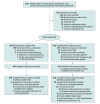Effect of Transcatheter Aortic Valve Implantation vs Surgical Aortic Valve Replacement on All-Cause Mortality in Patients With Aortic Stenosis: A Randomized Clinical Trial
- PMID: 35579641
- PMCID: PMC9115619
- DOI: 10.1001/jama.2022.5776
Effect of Transcatheter Aortic Valve Implantation vs Surgical Aortic Valve Replacement on All-Cause Mortality in Patients With Aortic Stenosis: A Randomized Clinical Trial
Abstract
Importance: Transcatheter aortic valve implantation (TAVI) is a less invasive alternative to surgical aortic valve replacement and is the treatment of choice for patients at high operative risk. The role of TAVI in patients at lower risk is unclear.
Objective: To determine whether TAVI is noninferior to surgery in patients at moderately increased operative risk.
Design, setting, and participants: In this randomized clinical trial conducted at 34 UK centers, 913 patients aged 70 years or older with severe, symptomatic aortic stenosis and moderately increased operative risk due to age or comorbidity were enrolled between April 2014 and April 2018 and followed up through April 2019.
Interventions: TAVI using any valve with a CE mark (indicating conformity of the valve with all legal and safety requirements for sale throughout the European Economic Area) and any access route (n = 458) or surgical aortic valve replacement (surgery; n = 455).
Main outcomes and measures: The primary outcome was all-cause mortality at 1 year. The primary hypothesis was that TAVI was noninferior to surgery, with a noninferiority margin of 5% for the upper limit of the 1-sided 97.5% CI for the absolute between-group difference in mortality. There were 36 secondary outcomes (30 reported herein), including duration of hospital stay, major bleeding events, vascular complications, conduction disturbance requiring pacemaker implantation, and aortic regurgitation.
Results: Among 913 patients randomized (median age, 81 years [IQR, 78 to 84 years]; 424 [46%] were female; median Society of Thoracic Surgeons mortality risk score, 2.6% [IQR, 2.0% to 3.4%]), 912 (99.9%) completed follow-up and were included in the noninferiority analysis. At 1 year, there were 21 deaths (4.6%) in the TAVI group and 30 deaths (6.6%) in the surgery group, with an adjusted absolute risk difference of -2.0% (1-sided 97.5% CI, -∞ to 1.2%; P < .001 for noninferiority). Of 30 prespecified secondary outcomes reported herein, 24 showed no significant difference at 1 year. TAVI was associated with significantly shorter postprocedural hospitalization (median of 3 days [IQR, 2 to 5 days] vs 8 days [IQR, 6 to 13 days] in the surgery group). At 1 year, there were significantly fewer major bleeding events after TAVI compared with surgery (7.2% vs 20.2%, respectively; adjusted hazard ratio [HR], 0.33 [95% CI, 0.24 to 0.45]) but significantly more vascular complications (10.3% vs 2.4%; adjusted HR, 4.42 [95% CI, 2.54 to 7.71]), conduction disturbances requiring pacemaker implantation (14.2% vs 7.3%; adjusted HR, 2.05 [95% CI, 1.43 to 2.94]), and mild (38.3% vs 11.7%) or moderate (2.3% vs 0.6%) aortic regurgitation (adjusted odds ratio for mild, moderate, or severe [no instance of severe reported] aortic regurgitation combined vs none, 4.89 [95% CI, 3.08 to 7.75]).
Conclusions and relevance: Among patients aged 70 years or older with severe, symptomatic aortic stenosis and moderately increased operative risk, TAVI was noninferior to surgery with respect to all-cause mortality at 1 year.
Trial registration: isrctn.com Identifier: ISRCTN57819173.
Conflict of interest statement
Figures


Comment in
-
Treatment of Aortic Stenosis With Transcatheter Aortic Valve Implantation.JAMA. 2022 May 17;327(19):1870-1871. doi: 10.1001/jama.2022.5424. JAMA. 2022. PMID: 35579656 No abstract available.
References
-
- Mack MJ, Leon MB, Smith CR, et al. ; PARTNER 1 Trial Investigators . 5-year outcomes of transcatheter aortic valve replacement or surgical aortic valve replacement for high surgical risk patients with aortic stenosis (PARTNER 1): a randomised controlled trial. Lancet. 2015;385(9986):2477-2484. doi:10.1016/S0140-6736(15)60308-7 - DOI - PubMed
Publication types
MeSH terms
LinkOut - more resources
Full Text Sources
Miscellaneous

